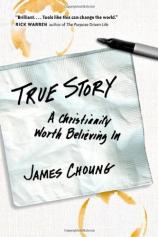True Story: A Christianity Worth Believing In
Review
True Story: A Christianity Worth Believing In
In the scriptural teachings, both Jesus and Paul use multiple paradigms or images to explain God’s redemptive work in the human heart and in the world. Here, James Choung, a divisional director of InterVarsity Christian Fellowship, introduces a model that seems to resonate with a new generation of seekers who have aspirations of changing the world.
Most of this book is a contemporary fictional narration “to illustrate the questions, struggles, joys and hopes surrounding the gospel.” Caleb, a Korean-American university student, has recently returned from a mission trip to Manila, where living “for six weeks with the urban poor had rent his heart wide open.” Back home in Seattle, Caleb shares his experience with his church community. Pastor Jeff listens with interest before asking the key question: “So how many got saved?” A restless Caleb leaves the gathering, wondering if there isn’t something more to Christianity than being “saved,” in the sense of being safe and secure in the life to come.
In concise one- or two-page “chapters,” Caleb’s story continues on two conversational fronts. He discusses life and faith with a fellow student, Anna, who says that “Christianity’s just another screwed-up religion!” In these conversations, Caleb is testing out and passing along insights he has recently gleaned from more in-depth discussions with a theology professor. In short, Caleb’s two-layered story is Choung’s effective teaching tool. The professor provides a theological basis for a presentation of the gospel that describes the kingdom of God in language that is gentler than the “man is sinful” take of “The Four Spiritual Laws.” Caleb’s encounters with Anna illustrate how this “new” approach might be presented to a questioning seeker. (In a recent Christianity Today magazine interview, Choung says it’s not a new approach but “the same old gospel truth.)
Like the “Four Spiritual Laws” booklet, used for decades to illustrate the gospel-good news, Choung reduces his presentation to a diagram that can fit on a diner’s napkin. Even so, he gives a disclaimer up front: “Now, I don’t believe a diagram will save the world, nor do I even think a diagram is the best way to share our faith. Nevertheless, diagrams are powerful…and have a great shaping influence on what we think about as the central message of the faith.” Choung’s diagram is based on four circles (or worlds), starting with a world that is “damaged by evil” rather than with a solitary person isolated by sin. God’s great plan is presented as God’s reconciliation with you, followed by his wonderful mission for you and fellow Christians to be “sent together to heal” the world that Jesus --- God incarnate --- came to “restore for better,” even now, before the final kingdom to come.
Conservative evangelicals may feel uncomfortable with Choung’s paradigm and choice of words. But there’s something refreshing here. And he has done an excellent job in making his case theologically, scripturally and metaphorically. He is not saying that other gospel presentations are wrong, but suggesting that they are incomplete --- even as his may be.
The last 30 pages of the book veer away from Caleb’s story and are more blatantly pedagogical, explaining how to use the “four-worlds” diagram, which Leonard Sweet has called “Choung’s ‘napkin theology.’”
I suggest that all Christians read this book with an open mind. Even if you remain suspicious, you’ll find tools here to draw people into discussion about faith in God and purpose in life.
Reviewed by Evelyn Bence on March 25, 2008
True Story: A Christianity Worth Believing In
- Publication Date: March 25, 2008
- Genres: Christian
- Paperback: 233 pages
- Publisher: IVP Books
- ISBN-10: 0830836098
- ISBN-13: 9780830836093




